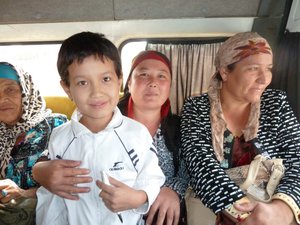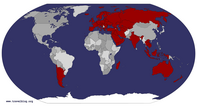Advertisement
Published: October 27th 2014

 Locals on the marshrutka to Navoi
Locals on the marshrutka to Navoi
I gave him the pen which he liked. They took a picture of us with their phone too.Samarkand October 26 2014
Throughout this trip we have tried to mix staying in cities with their easy transport links and rural visits. We found the Nurata Mountains had Uzbekistan's only community based tourism scheme. They are also conveniently located between Bukhara and Samarkand which were already on our route.
There are many organised tour options where you can get driven there in a 'private' car and the driver stays with you all the time. Our experience to date and also discussions with the CBT coordinator, Sherzod Norbekov (travelresponsible@gmail.com; www.nuratau.com), suggested we could travel independently and it would save money. On Sherzod's advice we did hire a guide for the first two days and Raslan (T: +998 9366110; raslan.naratau@mail.ru) proved a very valuable asset. We arranged to meet him in the 'jump off' town of Nurata. First we had to get there!
This was not difficult thanks to the helpfulness of drivers and clear instructions from Sherzod and Abdul in Bukhara. We got a marshrutka to Karvon Bazaar and fought off taxi drivers to find a marshrutka going in the direction of Navoi. He took us to Gijduvan, halfway, and then got

 The sacred spring at Nurata
The sacred spring at Nurata
You can see the trout in the water. The canal feeds the water to the town. The mosques can be seen too.us another marshrutka at the right rate. Again this driver helped us get a shared taxi to Nurata. We piled out of the car with all our gear in the centre of Nurata. We were not hard for Raslan to spot when he was expecting us.
With the bags stowed at his house he showed us around the central complex. Like all the towns and villages in this area Nurata exists because it has water. In fact it has a very plentiful spring which is the subject of devotion and offerings. The spring is 7 metres down at the back of the mosque. It is populated by a large number of remarkable trout that keep it clean. Raslan show us how remarkable they are: he took a large handful of grass and through it into the spring. Immediately way before it landed in the water all the fish started swimming to the point it was going to land. When it did reach the water there was a torrid frenzy and with in 20 seconds they had dispersed and there was no sign of any grass.
At the back of the mosques and spring is

 Following a visit to the money changer
Following a visit to the money changer
The notes I am holding have a vale of $50 or £32. We are learning to count notes fast. The locals are expert.the old fortress really just a muddy hill these days. The story goes that Alexander the Great took Nurata in whatever BC and the Tajik inhabitants escaped to the mountains where they have lived ever since.
His family gave us a super lunch and Raslan organised a car to take us to our destination in the mountains. This was the expensive bit (40USD) because hardly anyone goes to the mountains and it is 3 hours drive away in the middle of nowhere.
Nurata lies to the East of the mountains which are in a West East axis facing Lake Aidarkul and the border with Kasakhstan. The Tajik live in what the English would call spring line villages along the North side of the mountains. In fact they are more like oasis since the streams once through the village in the valley flow on to the semi-desert steppe and soon evaporate to nothing before they even reach the lake 25km away.
We were staying at Sentyab, the main centre for the tourism project with three guesthouses. They had build the guesthouses according to local traditions and met Westerns needs with sit down
loos, solar showers and beds. The family, Gulmurod and his wife, Rahima, and their 5 kids served us a simple meal of Plov (pilaf) cooked over an open fire. Rahima made bread in a tandoor oven. All our meals were served on a laid out tablecloth between thin mattresses on the floor. We sat cross legged to eat. All meals including breakfast started with bread, boiled sweets, nuts and dried fruit. At the end the remaining bread and crumbs are folded into the table cloth - it is all sacred and must not be thrown away.
There was definitely no internet, no gas and unreliable electricity so we retired soon after darkness.
Raslan led us on a hike up the valley next day. He was 24 and spoke English with a French accent! He could speak French, very helpful with the number of tourists from that country, Tajik (his mother tongue and rooted in Farsee), Uzbek (the language at school) and Russian. He was the oldest male in the family and seemed set on developing his own tourist business if his lottery application for a US green card did not come through. We can
certainly recommend Raslan as a guide. He was knowledgable about the area and patiently answered our questions.
It was a nice valley and the most interesting part of our walk was probably passing other inhabitants often on their donkeys. They were happy to have their photo taken. We passed a family loading wood on to a lorry having carried it up the slope of the valley to the road. It was the women who carried the wood whilst the men gave the orders. We also saw this at the guesthouses which would have not functioned without the women who cooked and cleaned as well as doing all their own household chores.
The next day Raslan was heading back to Nurata and we were moving 25km further on to the tiny village of Asraf. We both needed a lift going in opposite directions. A local driver took us to the main road junction which runs right along the base of the mountains and connects all the villages. We waited and not a single car passed us going in either direction for at least half an hour. The first car that did was going our way
and had space for us and our bags. So we got our ride to Asraf for a modest 15000 s'om (£3.70). They were proceeding to Tashkent. As you drive along the main road East the planer treeless steppe stretches into the distance on your left peppered occasionally by a flock of sheep and a shepherd on a donkey. To your right the mountains rise to 2000m brown and bare with the odd green streak of walnuts trees marking a village.
We found the Kakhshigul guesthouse and sat down to wait as no one was about. It did not matter as it was a warm sunny day. After an hour or so one of the brothers turned up with his family on an old Russian motorbike. His four year old son sat on the petrol tank in front of him and his wife sat on the back holding the two year old in her arms. We have not seen a crash helmet since Europe. We had our lunch of stewed chicken and potatoes outside.
That afternoon we set off to walk the 5km to the nearby village of Ukhum. This was over a series of

 The village Plov maker in Sentyab
The village Plov maker in Sentyab
He was cooking for a birthday. men sat at one set of tables , the women at another.ridges which gave us superb views of the steppe below and large birds of prey soaring above. We passed the odd shepherd with his flock and otherwise the only passers-by were a family of five with three donkeys. They shook our hands heartily and one man gave Jane an apple.
When we got to the village we met an old man in his chapan and he immediately invited us for tea. We took off our shoes and eat some bread which is the first thing you are offered when you enter any Uzbek home. His daughter-in-law brought out sweets and nuts with the green tea. The small children sat and stared at us like we were aliens (I guess we were). We had no common language between us and unfortunately the Russian phrase book was back at the guesthouse. It was getting late so we took photos, bade our farewells and headed back the way we came. It was getting quite dark by the time we got back with the sun having gone down below the mountains some time previously.
The next day the journey to Samarkand was similar to the way we had
come - a series of shared taxis between towns with increasing competition for our business as we got closer to the big city. The young boy racer who took us on the final leg to Samarkand tried the trick of taking us to the outskirts and saying it was extra to the city centre. I told him 'to bugger off and take us into the centrum' and it seemed to do the trick.
Whilst it was nice to be back in the city we knew we had had a fantastic experience seeing a way of life that is fast fading in many countries and which, judging by the number of young children we met, is set to continue in the Nurata mountains for some time. It made you think how many other rural areas there must be in Uzbekistan which are worth visiting away from the normal tourist routes. Do go there if you get the chance.
Advertisement
Tot: 0.053s; Tpl: 0.014s; cc: 9; qc: 24; dbt: 0.0298s; 1; m:domysql w:travelblog (10.17.0.13); sld: 1;
; mem: 1.1mb














